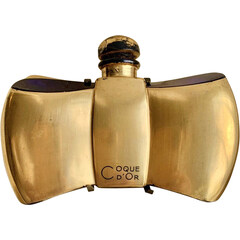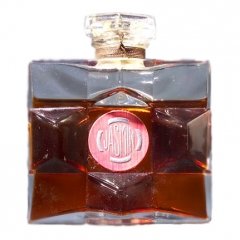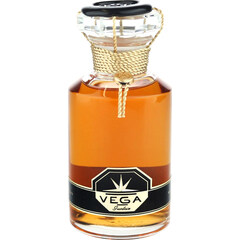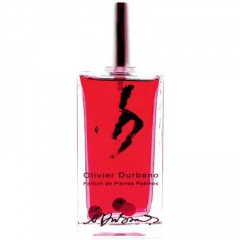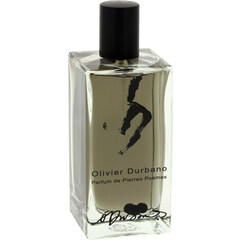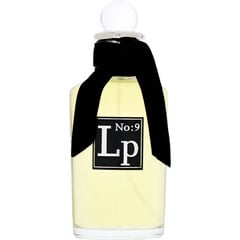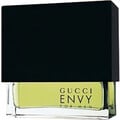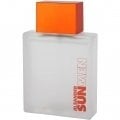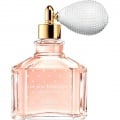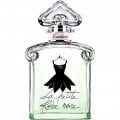
DemonHead
Reviews
Filter & sort
Derby's Great Aunt
Guerlain's Coque d'Or (Golden Shell) perfume was created in 1937 by Jacques Guerlain, and is easily recognisable for its beautiful gilded Baccarat blue bow-shaped flacon. It was created in the art deco age where lavishness and opulence was the norm, and its beautiful golden perfume presentation demonstrates this. Coque d'Or was additionally released in the quadrilobe flacon, as well as goutte and papillion bottles, and is a scent that typifies the glamour and mystique of this era.
Coque d'Or represents for me, some of Jacques Guerlain's most underappreciated work... it is a sensuous leathery fragrance that I feel might have been a pre-cursor to another much-loved men's Guerlain fragrance; but more on that later.
My vintage Coque d'Or eau de toilette reveals a citrus opening over an aromatic floral heart. I detect rose and something like soft iris or violets and a piquancy furnished by slightly peppery carnations and notes of nutmeg or mace. However, there is a beguiling buttery leather accord that features, and it is one that I've smelled before... it reminds me of paper-thin hand-made antique gloves of the most exceptional quality. As the perfume evolves further, curls of creamy sandalwood appear and an ambery facet (labdanum and vanilla?) brings with it a glowing sense of warmth. The whole composition rests on a glorious oakmoss base that rivals the best of other Guerlain greats. Coque d'Or is a sultry skinscent that gets better and better the longer it rests on the skin.
I would not be surprised if Jacques Guerlain's grandson Jean-Paul Guerlain perhaps drew upon the aromatic leather/oakmoss marriage of Coque d'Or as inspiration behind the mens aromatic leather fougère Derby. Whilst the two have topnotes that diverge in style and composition (florals in the former vs peppermint in the latter), their heart and basenotes run somewhat parallel. Derby is heralded as Guerlain's most revered male leather scent, and has qualities I find comparable to his Great Aunt.
I think many would welcome the return of Coque d'Or in the permanent perfume portfolio at 68 Champs Elysées. For my money, I find it a must-try for each and every Guerlainophile.
Coque d'Or represents for me, some of Jacques Guerlain's most underappreciated work... it is a sensuous leathery fragrance that I feel might have been a pre-cursor to another much-loved men's Guerlain fragrance; but more on that later.
My vintage Coque d'Or eau de toilette reveals a citrus opening over an aromatic floral heart. I detect rose and something like soft iris or violets and a piquancy furnished by slightly peppery carnations and notes of nutmeg or mace. However, there is a beguiling buttery leather accord that features, and it is one that I've smelled before... it reminds me of paper-thin hand-made antique gloves of the most exceptional quality. As the perfume evolves further, curls of creamy sandalwood appear and an ambery facet (labdanum and vanilla?) brings with it a glowing sense of warmth. The whole composition rests on a glorious oakmoss base that rivals the best of other Guerlain greats. Coque d'Or is a sultry skinscent that gets better and better the longer it rests on the skin.
I would not be surprised if Jacques Guerlain's grandson Jean-Paul Guerlain perhaps drew upon the aromatic leather/oakmoss marriage of Coque d'Or as inspiration behind the mens aromatic leather fougère Derby. Whilst the two have topnotes that diverge in style and composition (florals in the former vs peppermint in the latter), their heart and basenotes run somewhat parallel. Derby is heralded as Guerlain's most revered male leather scent, and has qualities I find comparable to his Great Aunt.
I think many would welcome the return of Coque d'Or in the permanent perfume portfolio at 68 Champs Elysées. For my money, I find it a must-try for each and every Guerlainophile.
An early gourmand
Jasmin first appeared in the Guerlain perfume portfolio in 1924. It emerged post-WWI, just as the world swung into a brand new age of optimism and a renewed social consciousness.
Originally presented in the 'quadrilobe' flacon, and later in 'goutte', 'rosebud' and cobalt Baccarat presentations, Jasmin was one of Jacques Guerlain's numerous soliflore interpretations.
Perhaps what I find most beautiful about my vintage eau de toilette, is that it is not a straight-forward jasmine fragrance. For a single-flower scent, it is really rather complex.
The opening impression is of mildly indolic jasmine blossoms... rich and opulent; however its potency is somewhat short-lived. One becomes aware of a sharp undertone of lily of the valley which provides a crisp green constituent as the jasmine notes suddenly diminish by half. Five or six minutes later, a saccharine honey/vanilla accord emerges that reminds me of chewy Laudurée jasmine macaroons. Notes of pale wood bestow a slightly bitter "toasted" vibe.
One cannot deny the sweetness of this scent which, for its time, sometimes borders on the gourmand. Whilst evoking a sense of prettiness and youth, one can also recognise a more responsible, considered base of oakmoss.
Jasmin dances between juvenescence and adulthood... a soliflore that celebrates women both young, and those young at heart.
Originally presented in the 'quadrilobe' flacon, and later in 'goutte', 'rosebud' and cobalt Baccarat presentations, Jasmin was one of Jacques Guerlain's numerous soliflore interpretations.
Perhaps what I find most beautiful about my vintage eau de toilette, is that it is not a straight-forward jasmine fragrance. For a single-flower scent, it is really rather complex.
The opening impression is of mildly indolic jasmine blossoms... rich and opulent; however its potency is somewhat short-lived. One becomes aware of a sharp undertone of lily of the valley which provides a crisp green constituent as the jasmine notes suddenly diminish by half. Five or six minutes later, a saccharine honey/vanilla accord emerges that reminds me of chewy Laudurée jasmine macaroons. Notes of pale wood bestow a slightly bitter "toasted" vibe.
One cannot deny the sweetness of this scent which, for its time, sometimes borders on the gourmand. Whilst evoking a sense of prettiness and youth, one can also recognise a more responsible, considered base of oakmoss.
Jasmin dances between juvenescence and adulthood... a soliflore that celebrates women both young, and those young at heart.
Vintage starlight
Few know that Jacques Guerlain had a significant interest in astronomy, and that he frequently pored over published dissertations on the subject. It is no surprise then, that in 1936 he came to draw inspiration from the 5th brightest star in the night sky, and one that has been referenced in ancient mythology for millennia: Véga.
Originally released in the iconic Baccarat "inkwell" flacon, Véga typified the new and innovative perfume stylings of the Art Deco age. Only 15 years earlier, Coco Chanel had released her aldehydic beast Chanel No.5 onto the world stage to great acclaim, which resulted in a mass tendency towards the use of aldehydes in perfumery. In answer to Chanel's ground-breaking creation, Jacques Guerlain released the aldehyde-rich luminous floral Liu in 1927, and revisited the aldehydic theme in Véga; though this time with a masterfully measured hand. Véga presented aldehydes in a vastly different manner - somehow scattered and diminished - as if the scent itself, much like starlight, had travelled for millennia across space and time.
Véga has all the markers of a classic aldehydic perfume but for one thing: a generous dose of vanilla. It opens with a sharp floral crispness that rushes to dry the back of the nose... bright neroli and ylang ylang accompany strong aldehydes through the topnotes, but a denser velvety heart of rose rests just under the surface. This strokeable rose accord harmonises with the powdery aspect of the aldehydes, and the whole heart of the perfume suddenly becomes very tactile. A dewy, thick vanilla note materialises, and adds a feeling of creamy, ambery warmth. This is where I feel Véga and other classic floral aldehydes diverge in style... it feels as if with Jacques Guerlain's interpretation, he has shifted the radio transmission a little 'off' to receive signals through a screen of white noise and static. The white/yellow florals are still there, but seem to be flourishing under a cream-coloured blanket of cashmere-soft vanilla. There is a lingering trail of subtle woods in the drydown: dry vetiver and what I expect might be fragrant sandalwood.
When pitted against the 2006 reissued version, the vintage Véga edt wins me over just by a hair. There just seems to be a celestial harmony between the notes that makes it slightly easier to wear than the modern release. As with the heavenly body itself, I feel the light of 1930's Véga might have changed ever-so-slightly in the time it has taken to reach us here in 2013.
Originally released in the iconic Baccarat "inkwell" flacon, Véga typified the new and innovative perfume stylings of the Art Deco age. Only 15 years earlier, Coco Chanel had released her aldehydic beast Chanel No.5 onto the world stage to great acclaim, which resulted in a mass tendency towards the use of aldehydes in perfumery. In answer to Chanel's ground-breaking creation, Jacques Guerlain released the aldehyde-rich luminous floral Liu in 1927, and revisited the aldehydic theme in Véga; though this time with a masterfully measured hand. Véga presented aldehydes in a vastly different manner - somehow scattered and diminished - as if the scent itself, much like starlight, had travelled for millennia across space and time.
Véga has all the markers of a classic aldehydic perfume but for one thing: a generous dose of vanilla. It opens with a sharp floral crispness that rushes to dry the back of the nose... bright neroli and ylang ylang accompany strong aldehydes through the topnotes, but a denser velvety heart of rose rests just under the surface. This strokeable rose accord harmonises with the powdery aspect of the aldehydes, and the whole heart of the perfume suddenly becomes very tactile. A dewy, thick vanilla note materialises, and adds a feeling of creamy, ambery warmth. This is where I feel Véga and other classic floral aldehydes diverge in style... it feels as if with Jacques Guerlain's interpretation, he has shifted the radio transmission a little 'off' to receive signals through a screen of white noise and static. The white/yellow florals are still there, but seem to be flourishing under a cream-coloured blanket of cashmere-soft vanilla. There is a lingering trail of subtle woods in the drydown: dry vetiver and what I expect might be fragrant sandalwood.
When pitted against the 2006 reissued version, the vintage Véga edt wins me over just by a hair. There just seems to be a celestial harmony between the notes that makes it slightly easier to wear than the modern release. As with the heavenly body itself, I feel the light of 1930's Véga might have changed ever-so-slightly in the time it has taken to reach us here in 2013.
A compelling creation
French jeweller/perfumer Olivier Durbano has an insatiable approach to his work. His eye-popping collars of semi-precious stones are constructed with both a masterful hand, and a keen consciousness of the raw materials he is working with. In 2012, Durbano chose the stone Heliotrope to feature in his work, and true to his own tradition, it also served as the inspiration behind his latest perfume release, which he revealed at Fragranze in Italy last month.
Heliotrope is known perhaps more commonly as Bloodstone, or Dragonstone; a variety of chalcedony which is chiefly a deep green colour, speckled with rich red jasper. Worn as a talisman to protect against the evil eye, and to aid with blood-related disorders, it has been a stone coveted throughout the ages by both Christians and pagans.
As with all of Durbano's perfumes - one can't help but recognise a hint of antiquity at hand. Not antiquity so much in the sense that his creations are like the classical pillars of perfumery, but rather "antiquity" defined in a primitive sense. Heliotrope is such a scent... one that commands instant reflection... it conjures scenes from archaic ages... of warring empires and primordial battles; of far-flung cities buried in the sand; of the prehistoric asclepions and sanctuaries of healing.
Perhaps more than any other of his accomplished perfume releases, Héliotrope not only memorialises this semi-precious stone, but also tells an ancient narrative.
One does not quite know what to expect when first applying this deep crimson juice, or perhaps if one does, I am almost certain their assumptions would be wrong. Heliotrope opens with a sharp mandarin accord, but it is instantly diminished by a combustable chilli-pepper warmth. A component of many fragrances from the Near East, saffron is a major player here... it is heady and piquant. It's texture is syrupy, almost medicinal in nature, which adds complexity and a sense of luxuriousness. I sense florals - angelica, magnolia, heliotrope - swimming at its heart, but there is also a curious sense of green.
A damp, sodden woodsy green, like the smell of the forest floor after a deluge. I've not smelled Nagarmotha as an isolated raw ingredient, but it is listed as a component here, and I recognise it from other scents like Amouage's Opus VI and Mona di Orio's Oud, and I feel it contributes to this grassy, woody, slightly astringent aspect. Notes of sandalwood and cedar also bring with them a bountiful sense of comfort.
As it develops, Heliotrope feels multi-tiered with layers of warmth and coolness... a huff of musk lends a luke-warm "organic" feel... like the smell of skin at blood-temperature. I ponder for a moment, wondering if this was a deliberate (and genius) attribute to include. Durbano's remarkable and much loved "house accord" of incense and tree resins makes a firm appearance in Héliotrope's drydown... lavish tendrils of myrrh, oliban and benzoin which furnish each of his perfumes with an exquisite earthy, mineralic quality.
There is something resolutely personal about how this perfume blossoms over time... it feels both intimate and curative. I imagine an ancient spa or asclepion with clay pots full of salves, unguents and balms that are rubbed into tired muscles and anoint the wounds of ancient heroes and heroines. Héliotrope, the perfume, stays true to the stone's metaphysical purpose... is indeed reparative and protective.
Once again, Monsieur Durbano's incomparable cognizance of stones and their spiritual meaning makes for a compelling and thought-provoking creation.
One of his very best.
Heliotrope is known perhaps more commonly as Bloodstone, or Dragonstone; a variety of chalcedony which is chiefly a deep green colour, speckled with rich red jasper. Worn as a talisman to protect against the evil eye, and to aid with blood-related disorders, it has been a stone coveted throughout the ages by both Christians and pagans.
As with all of Durbano's perfumes - one can't help but recognise a hint of antiquity at hand. Not antiquity so much in the sense that his creations are like the classical pillars of perfumery, but rather "antiquity" defined in a primitive sense. Heliotrope is such a scent... one that commands instant reflection... it conjures scenes from archaic ages... of warring empires and primordial battles; of far-flung cities buried in the sand; of the prehistoric asclepions and sanctuaries of healing.
Perhaps more than any other of his accomplished perfume releases, Héliotrope not only memorialises this semi-precious stone, but also tells an ancient narrative.
One does not quite know what to expect when first applying this deep crimson juice, or perhaps if one does, I am almost certain their assumptions would be wrong. Heliotrope opens with a sharp mandarin accord, but it is instantly diminished by a combustable chilli-pepper warmth. A component of many fragrances from the Near East, saffron is a major player here... it is heady and piquant. It's texture is syrupy, almost medicinal in nature, which adds complexity and a sense of luxuriousness. I sense florals - angelica, magnolia, heliotrope - swimming at its heart, but there is also a curious sense of green.
A damp, sodden woodsy green, like the smell of the forest floor after a deluge. I've not smelled Nagarmotha as an isolated raw ingredient, but it is listed as a component here, and I recognise it from other scents like Amouage's Opus VI and Mona di Orio's Oud, and I feel it contributes to this grassy, woody, slightly astringent aspect. Notes of sandalwood and cedar also bring with them a bountiful sense of comfort.
As it develops, Heliotrope feels multi-tiered with layers of warmth and coolness... a huff of musk lends a luke-warm "organic" feel... like the smell of skin at blood-temperature. I ponder for a moment, wondering if this was a deliberate (and genius) attribute to include. Durbano's remarkable and much loved "house accord" of incense and tree resins makes a firm appearance in Héliotrope's drydown... lavish tendrils of myrrh, oliban and benzoin which furnish each of his perfumes with an exquisite earthy, mineralic quality.
There is something resolutely personal about how this perfume blossoms over time... it feels both intimate and curative. I imagine an ancient spa or asclepion with clay pots full of salves, unguents and balms that are rubbed into tired muscles and anoint the wounds of ancient heroes and heroines. Héliotrope, the perfume, stays true to the stone's metaphysical purpose... is indeed reparative and protective.
Once again, Monsieur Durbano's incomparable cognizance of stones and their spiritual meaning makes for a compelling and thought-provoking creation.
One of his very best.
Hard-hitting and enigmatic
In my book, French jeweller/perfumer Olivier Durbano can do no wrong.
This scent immediately unfurls with a swelling cloud of sharp black pepper and thick smoked wood... the sensation is intense and palpable; somewhat akin to inhaling the hot, heavy air inside a sauna. All the while, a rich bouquet garni of fragrant spices - cardamom, coriander and cumin - simmer beneath the surface and imbue the air with their dry, aromatic piquancy. A hiss of oudh lends an opulent richness to the composition, and it snakes its way across the glorious frankincense that I have come to recognise as the starring accord in all of Durbano's perfume creations. It is this wonderful incense/resin that is also common to Amethyste and Rock Crystal, and here, it contributes a profound 'otherworldly' appeal. As the fragrance evolves, these accords shift and interweave with dark patchouli, amber and dry woods.
Black Tourmaline is a hauntingly beautiful eau de parfum. It has phenomenal sillage and remarkable persistence, and can be enjoyed by both men and women.
Much in the same way black tourmalines were once worn by the ancients for their protection against evil; one might also wear this scent as somewhat of a 'perfume talisman'... one that strikes a curious balance between the earthbound, and the ethereal.
This scent immediately unfurls with a swelling cloud of sharp black pepper and thick smoked wood... the sensation is intense and palpable; somewhat akin to inhaling the hot, heavy air inside a sauna. All the while, a rich bouquet garni of fragrant spices - cardamom, coriander and cumin - simmer beneath the surface and imbue the air with their dry, aromatic piquancy. A hiss of oudh lends an opulent richness to the composition, and it snakes its way across the glorious frankincense that I have come to recognise as the starring accord in all of Durbano's perfume creations. It is this wonderful incense/resin that is also common to Amethyste and Rock Crystal, and here, it contributes a profound 'otherworldly' appeal. As the fragrance evolves, these accords shift and interweave with dark patchouli, amber and dry woods.
Black Tourmaline is a hauntingly beautiful eau de parfum. It has phenomenal sillage and remarkable persistence, and can be enjoyed by both men and women.
Much in the same way black tourmalines were once worn by the ancients for their protection against evil; one might also wear this scent as somewhat of a 'perfume talisman'... one that strikes a curious balance between the earthbound, and the ethereal.

 DemonHead
DemonHead